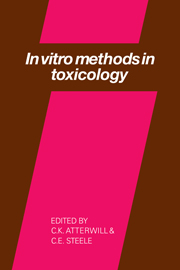Book contents
- Frontmatter
- Contents
- List of contributors
- Preface
- Introduction
- TARGET ORGAN TOXICITY
- In vitro methods in renal toxicology
- Ototoxicity
- Cultured cell models for studying problems in cardiac toxicology
- Use of the isolated rat heart for the detection of cardiotoxic agents
- Brain reaggregate cultures in neurotoxicological investigations
- Application of thryoid cell culture to the study of thyrotoxicity
- In vitro methods to investigate toxic lung disease
- Metabolism and toxicity of drugs in mammalian hepatocyte culture
- In vitro evaluation of haemic systems in toxicology
- GENERAL AND TOPICAL TOXICITY
- REPRODUCTIVE TOXICITY
- CONCLUSION
- Index
Metabolism and toxicity of drugs in mammalian hepatocyte culture
Published online by Cambridge University Press: 06 August 2010
- Frontmatter
- Contents
- List of contributors
- Preface
- Introduction
- TARGET ORGAN TOXICITY
- In vitro methods in renal toxicology
- Ototoxicity
- Cultured cell models for studying problems in cardiac toxicology
- Use of the isolated rat heart for the detection of cardiotoxic agents
- Brain reaggregate cultures in neurotoxicological investigations
- Application of thryoid cell culture to the study of thyrotoxicity
- In vitro methods to investigate toxic lung disease
- Metabolism and toxicity of drugs in mammalian hepatocyte culture
- In vitro evaluation of haemic systems in toxicology
- GENERAL AND TOPICAL TOXICITY
- REPRODUCTIVE TOXICITY
- CONCLUSION
- Index
Summary
INTRODUCTION
Drugs and xenobiotics exert toxic effects by a variety of mechanisms. The toxic response is often organ specific and may be caused by either parent drug or by metabolites of the drug. Information gained on the hepatic metabolism of drugs, therefore, is of general value in helping to understand toxicity caused by a drug because the liver is a major site of metabolic elimination of drugs and has a marked effect on determining the exposure of a specific organ to either parent drug or metabolite. Moreover, specific drugs may cause toxicity by directly acting on the hepatocyte or indirectly as a consequence of induction or inhibition of hepatic metabolic pathways.
For these and other considerations it is important to obtain information on the hepatic metabolism of new drugs as early as possible. In practice, metabolic and pharmacokinetic input in drug discovery is not usually substantial and the reasons for this are various, but generally centre on the resources and time required to develop and conduct appropriate metabolism studies.
One approach to this problem is to introduce in vitro methodology at an early stage of the analysis of drug metabolism and pharmacokinetics. Hepatocytes retain most of the metabolic capabilities of the intact liver (Abraham et al., 1983; Tsuru et. al., 1982; Davis et al., 1983) and provide an opportunity to study both the pathways and extent of metabolism of novel drugs at a very early stage in the drug development process.
- Type
- Chapter
- Information
- In Vitro Methods in Toxicology , pp. 211 - 234Publisher: Cambridge University PressPrint publication year: 1987
- 1
- Cited by



